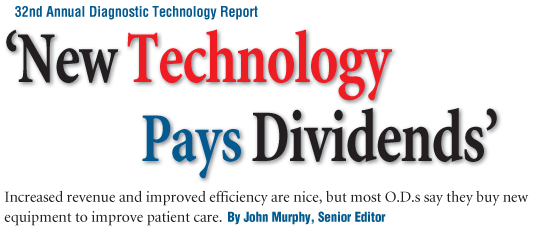
About two years ago, optometrist Thomas R. Benthien bought a digital fundus camera for his
When Dr. Benthien first got the camera, he used it on all his patients. One year later, a 33-year-old white female patient returned, and her photos were retaken. "When viewing the photos from the previous year, we could see there was some slight swelling of the nerve heads, which I had missed with direct ophthalmoscopy," he says. "I immediately thought of pseudotumor cerebri, but she had had no significant weight loss recently."
Dr. Benthien eventually made sure she saw a neuro-ophthalmologist, who found a space-occupying brain tumor in the calcarine area of her occipital lobe.
"She was operated on and is doing very well today," Dr. Benthien says. "Needless to say, she was very happy with us."
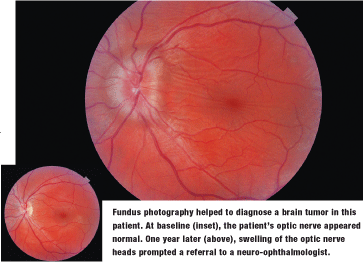
This patient's story exemplifies one key statistic: Four out of five optometrists (80%) say that the most important factor for buying new diagnostic technology is to improve patient care.
Sure, new technology can increase revenue--8% of respondents say that's their primary reason for buying new equipment. And, new technology can improve office efficiency (5%) and increase a practice's marketability (1%). But, improving patient care is what makes that investment in new technology really mean something.
These are the results of our annual Diagnostic Technology Survey, based on the responses of 417 O.D.s to an e-mail questionnaire.
What's Hot Right Now
What is the number one piece of equipment that O.D.s are buying or want to buy? More than half (53%) say a digital fundus camera.
Among the other most wanted items: electronic medical record systems/practice management program (42%), corneal topographer (32%), automated refraction system (31%), digital anterior segment camera (28%), perimeter/visual field analyzer (27%) and ocular coherence tomographer (25%).
What is Your Most Important Reason for Buying New Technology?
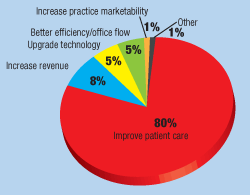
Digital fundus camera. Respondents to this survey could not say enough about the advantages of using a digital fundus camera.
Optometrist Larry Cusma, of
Tim Kirk, O.D., has a Canon digital fundus camera with computer access in all the exam rooms of his suburban
Has This New Technology Increased Your Profitability?
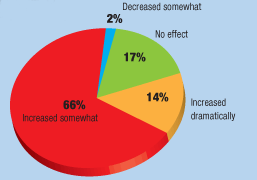
Electronic medical record (EMR)/practice management system. Briana Shelton, O.D., of
Corneal topographer. "[A new] topographer has allowed me to be the contact lens specialty fitter that I have held myself out to be," says optometrist Vanessa Loo Chang, O.D., of
Automated refraction system. Optometrist Jerry Ferrell, of
For Patients With Eye Diseases Such As Glaucoma or Diabetes, How Often Do You Perform a Dilated Fundus Examination?
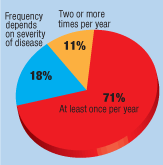
Dave Boeckman, O.D., of
Digital anterior segment camera. For her practice in
Keith Kajioka, O.D., of
Ocular coherence tomographer. Before Darin R. Cummings, O.D., bought an OCT for his practice in
Do You Currently Use an EMR System?
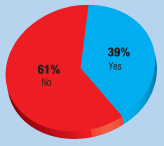
Optometrist Jeff Yunker says, "My OCT has been a boon to my medical optometric practice in
Nerve fiber analyzer. Terry Steckman, O.D., of
Since optometrist Diane Forecki purchased a Zeiss GDx in August 2008 for her Schaumburg,
Wide-field scanning laser ophthalmoscope. "I lease the [Optos] Optomap to increase patient flow and to decrease the number of patient dilations," says Brian VanDerPloeg, O.D., of
| What New Technology Are You Considering Purchasing (Or Have Purchased in the Last Three Years)? |
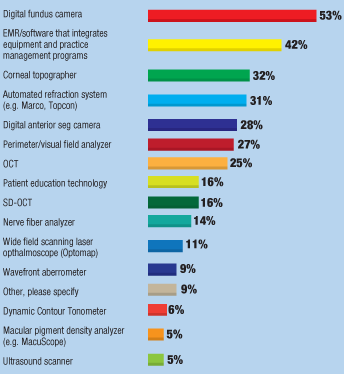 |
Other Results
This years technology survey also produced other interesting results:
-Just two out of five optometrists (39%) currently use an electronic medical records system.
-More than 70% of O.D.s have an instrument to measure corneal thickness, such as a pachymeter. (That means nearly 30% do not.)
-Between leasing and buying, 70% of O.D.s say they will buy their next major piece of equipment while 27% say they will lease.
-Regarding new vs. used equipment, 84% of respondents say they will buy or lease their next major equipment purchase, 15% say they will buy used or refurbished equipment, and 2% say they will repair existing equipment.
-About 14% of O.D.s share equipment with another doctors practice.
| How Much Will You Be Spending on Instruments and Equipment This Year? |
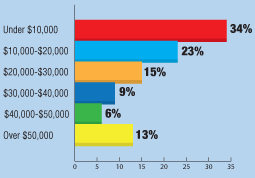 |
"Even in the current economic climate, optometrists find that investing in new technology is well worth it. I have found that the more I invest in my practice with new equipment, the more patients invest in me as their primary eye care physician," says Dr. Cummings. "New technology pays dividends!"

